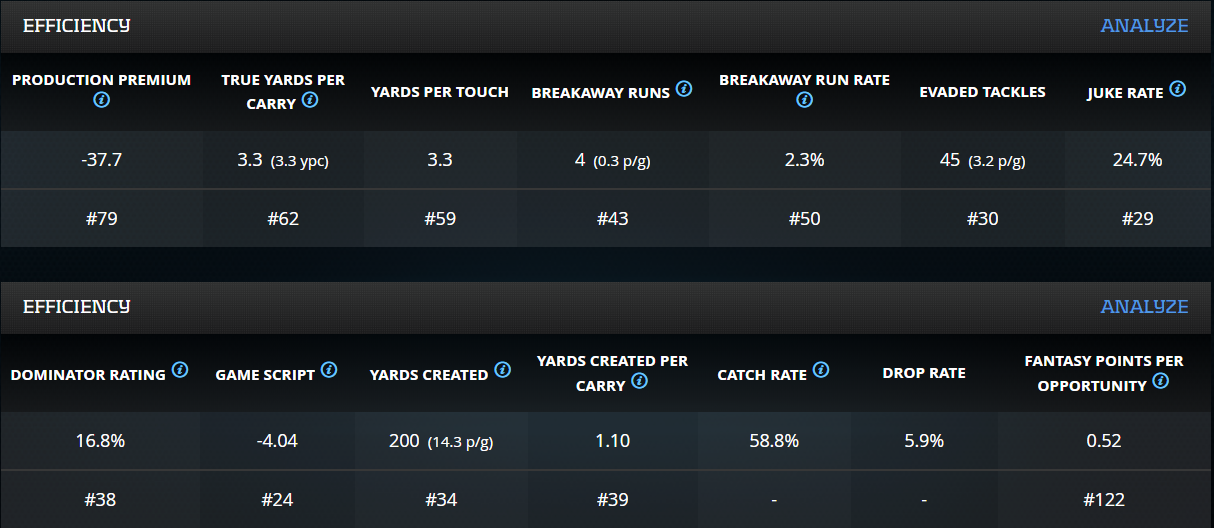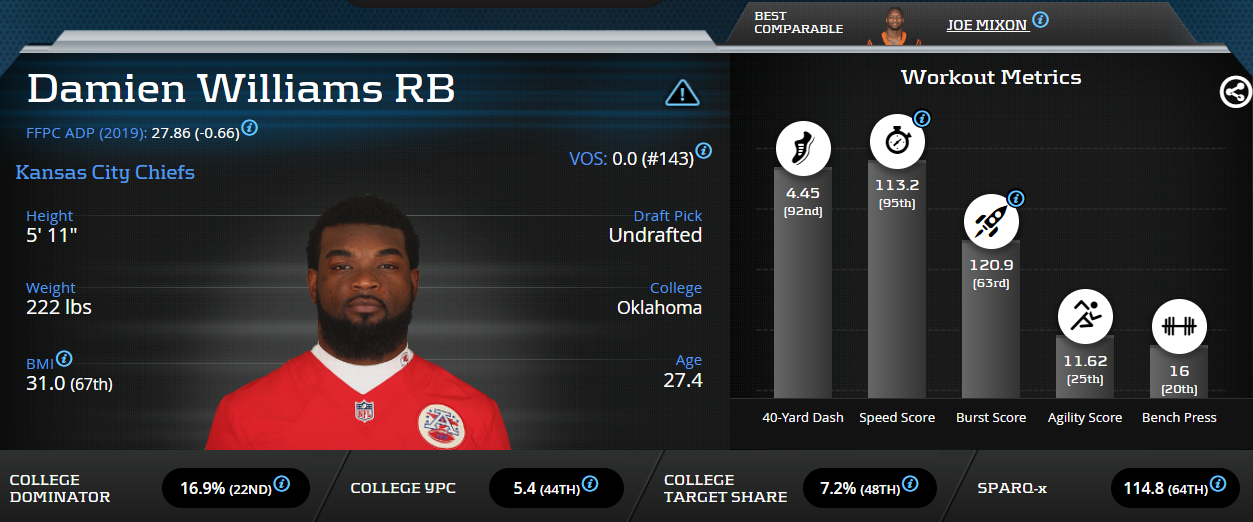This year’s 53 man cut-down date was eventful. Players such as LeSean McCoy and Carlos Hyde have relocated to Kansas City and Houston, respectively. Fantasy gamers need to decide what they now think about these backfields. The Saints running back touch distribution looked murky entering 2017, with Adrian Peterson, Alvin Kamara and Mark Ingram all projected to see work. Having the right approach to that backfield won many fantasy football championships. Taking the correct approach on the Chiefs and Texans backfields will be paramount to success in 2019. Here’s why fantasy gamers should fade the brand name veterans and buy Duke Johnson and Damien Williams, based on their advanced stats and metrics.
Carlos Hyde’s Presence
Carlos Hyde’s value took a precipitous fall in the 2018-2019 season. He went from being a low-grade bell-cow in Cleveland to a journeyman. This is significant because over the last 10 years, players such as Justin Forsett and Adrian Peterson had career seasons with teams that didn’t draft them. Justin Forsett didn’t have a next season. Adrian Peterson did muster an RB19 season, albeit with zero competition for touches thanks to Derrius Guice and Chris Thompson injuries. Peterson is also not a normal human being.
Decidedly more mortal is Hyde, who does have competition. His recent work on the field does little to inspire confidence. He recorded 3.3 (No. 62 among qualified players) True Yards per carry. Hyde did face a 40-percent (No. 2) Stacked Front carry rate, but was also not adding much to the equation. His subpar elusiveness was evident in his 3.2 Evaded Tackles per game and his 1.10 (No. 39) Yards Created per carry. He’s out there getting what’s blocked. Hyde may still have a role in the real life NFL with the yearly attrition at the RB position, but he has as much fantasy relevance as a goldfish that’s been swimming upside down for a few days now.
LeSean McCoy’s Arrival
LeSean McCoy has been an NFL mainstay for close to a decade and deserves Hall Of Fame consideration. That being said, professional football is a young man’s game. Despite having a great career to this point, McCoy has now compiled 2,346 career carries and 475 receptions. Other once-productive RB’s at similar points in their career include LaDainian Tomlinson (RB35 in 2011), Frank Gore (RB48 in 2018), Steven Jackson (RB123 in 2015) and Matt Forte (RB41 in 2017). To expect a top-24 performance from McCoy would be unprecedented in recent history.
Check out LeSean McCoy on PlayerProfiler’s “World Famous” Draft Kit:
On a team wherein McCoy was the entrenched starter in 2018, he mustered a 52.7-percent (No. 25) Opportunity Share in 14 games played. Known for his ability to cut on a dime, McCoy recorded a 24.6-percent (No. 30) Juke Rate. He had a disappointing 3.1 (No. 66) True Yards per carry. He did this while facing a mere 17.4-percent (No. 34) Stacked Front carry rate. McCoy’s long speed appears to be diminished, evidenced by a 3.1-percent (No. 47) Breakaway Run Rate. Teams may be willing to take a shot on late-career McCoy this year, possibly even next. NFL fans may still be treated to a few more jaw dropping, impossibly sudden stop and go’s. We should expect something similar to Forte’s 2017 campaign where he still had the odd top 12 week, but finished outside the top 40 at RB and far from being the primary back.
Historical Comps
In the 2018-2019 season, Carlos Hyde finished at RB49 and LeSean McCoy at RB39. Running backs who played the majority of their age 29-plus season and then moved teams went on to finish between RB55 and RB109. These players are not scrub comparisons. They all recorded either a top 12 season at the position or multiple top-24 seasons. In 2018, Hyde registered 28-percent of the carries and two-percent of the targets in Cleveland. McCoy fared a little better with 34-percent of his team’s carries and 10-percent of the targets. The players in the historical comparison were in the same range before changing teams, and only averaged 27-percent of carries plus targets on their new teams. More relevant to fantasy, and definitely more actionable, their teammates included 2010 Matt Forte (RB9), 2011 Ray Rice (RB1) and 2010 Frank Gore (RB16).
In 2018, Hyde registered 28-percent of the carries and two-percent of the targets in Cleveland. McCoy fared a little better with 34-percent of his team’s carries and 10-percent of the targets. The players in the historical comparison were in the same range before changing teams, and only averaged 27-percent of carries plus targets on their new teams. More relevant to fantasy, and definitely more actionable, their teammates included 2010 Matt Forte (RB9), 2011 Ray Rice (RB1) and 2010 Frank Gore (RB16).
There are successes from older RBs moving teams late in their careers. The successful late career movers were still consuming about 58-percent of their team’s carries and targets prior to the move. The only exceptions were players that were injured prior to moving and missed significant time, depressing their opportunity share. Once players are healthily playing and not demanding the volume they once did, the end is near.
Damien Williams Outlook
Damien Williams is a divisive player. The detractors would say that he’s a product of the Chiefs backfield. That’s true to an extent, but Williams brought value to the table. While playing for the Chiefs in 2018, Williams a 10-percent Breakaway Run Rate. Kareem Hunt, in the same offense, posted a 6.1-percent (No. 15) Breakaway Run Rate. Williams posted 1.33 (No. 11) Fantasy Points per Opportunity, similar to James White and Duke Johnson, showing elite RB pass catching skill. Hunt, again in the same offense as Williams, posted only 1.07 (No. 28) Fantasy Points per Opportunity. Williams’ Juke Rate of 34.2-percent is similar to Melvin Gordon’s 35.1-percent (No. 5) mark. His 1.67 (No. 12) Yards Created per carry was more than Joe Mixon’s 1.60 (No. 15) mark. He’s more than a warm body in an enviable position.
The Chiefs scored the most points in the NFL in 2018. Their future is bright, even if they may not repeat that feat at such a phenomenal pace. Although the Chiefs only ran the 23rd-most run plays, they had the 16th-most rushing yards from scrimmage and seventh-most rushing TDs. They were also sixth with 4.8 Team Yards per attempt. This is an offense that’s more than capable of supporting two relevant fantasy backs. At this point, I would be more willing to bet on Darwin Thompson and Damien Williams being in the top 24 than LeSean McCoy.
Duke Johnson Outlook
In many ways, the Texans rival Kansas City in being a productive backfield. Houston had the fourth most rush attempts in 2018, was eighth in yards and 11th in points. They now insert a player in Duke Johnson who was only getting 43-percent of snaps, and still managed to be 16th in targets among RBs with 62. Johnson did that on the same field as Jarvis Landry. Opinions about Landry vary, but he gets targets. Johnson’s +33.7 (No. 5) Production Premium compares favorably to former teammate Nick Chubb’s +6.7 (No. 27) Production Premium. It dwarfs what Carlos Hyde did in that offense with his -37.7 (No. 79) number. It’s nothing new. In 2017, Duke was also fifth with a +46.3 mark. Year in and year out, Duke does the most with whatever he’s given.
https://www.youtube.com/watch?v=_6ZqvpoXINA
It’s only fair to mention the fact that he is Miami University’s all-time leading rusher. He outperformed other Miami U grads such as Frank Gore, Willis McGahee, and even Lamar Miller. Johnson will be filling the shoes of a player in Miller who was top 20 in Weighted Opportunity and red zone touches. Employing him has the potential to reshape this offense, because targeting RB on early downs is much more efficient in today’s NFL than letting Miller or Hyde go out and get what’s blocked.
Conclusion
Texans and Chiefs coaches may have a different opinion of their free-agent additions than those stated here. While that does matter, coaches have to win. Sooner or later, players such as Duke Johnson and Damien Williams find a way to showcase their talent. History is not on the side of these once productive veteran backs being reinvigorated by new surroundings. It makes more sense to bet on the young talent being given a chance to shine.







